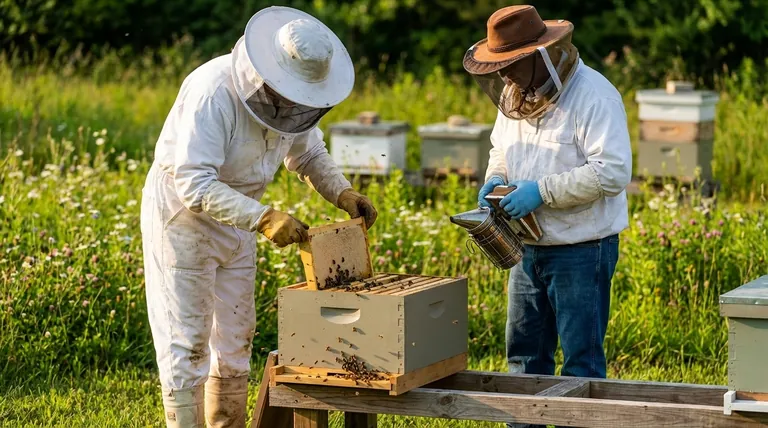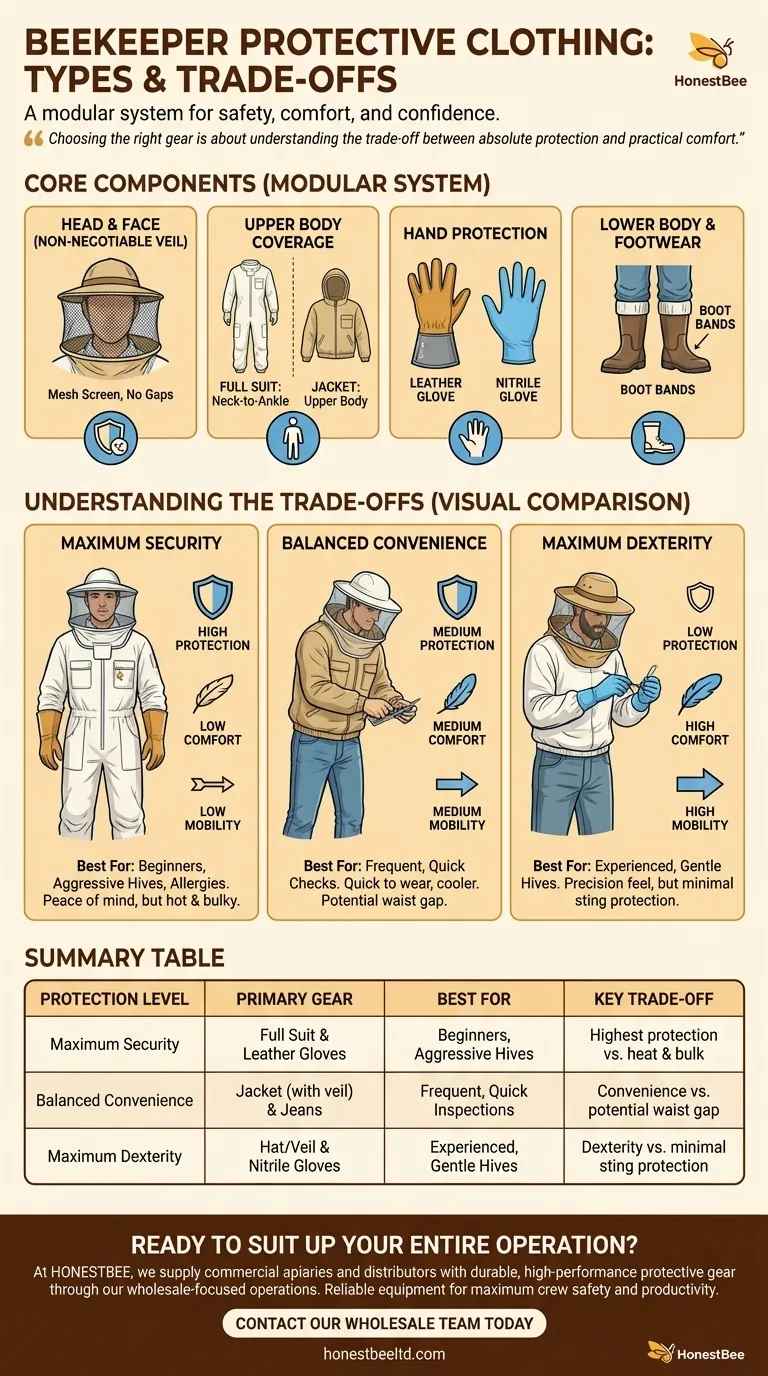Protective clothing for beekeepers is a modular system designed to prevent stings, ranging from essential head coverings to full-body suits. The primary components include a veil for the face and neck, a jacket or full suit for the torso and limbs, and gloves to protect the hands. Beekeepers select their gear based on the task, the temperament of the bees, and their personal comfort level with potential exposure.
Choosing the right gear is not about finding a single "best" outfit, but about understanding the trade-off between absolute protection and practical comfort. The fundamental goal is to create a barrier that allows you to work calmly and confidently, with a quality veil being the one indispensable element for any beekeeper.

The Core Components of Beekeeper Protection
Beekeeping gear is best understood as a system of layers and components, each serving a specific purpose. You can mix and match these pieces to suit your needs.
Head and Face Protection: The Non-Negotiable Veil
The single most critical piece of protective equipment is the veil. Stings to the face, particularly around the eyes, nose, and mouth, are uniquely dangerous and painful.
A veil is a mesh screen that covers your face and neck. It is typically attached to a hat or a helmet, or integrated directly into a beekeeping jacket or suit, ensuring there are no gaps for bees to enter.
Upper Body Coverage: The Suit vs. The Jacket
The most common decision for body protection is choosing between a full suit and a jacket.
A beekeeping jacket covers your entire upper body and arms and almost always includes an integrated veil. It is popular because it's easy to put on over a regular shirt and pants for quick hive inspections.
A full beekeeping suit provides complete, one-piece coverage from your neck to your ankles. It offers the highest level of protection by eliminating the gap at the waist where a jacket and pants meet.
Hand Protection: Gloves and Dexterity
Beekeeping gloves protect your hands and wrists, a common target for stings. They are typically made of leather or goat skin and feature long sleeves, called gauntlets, that extend over the cuffs of your suit or jacket.
Some experienced beekeepers opt for thinner nitrile or latex gloves. These offer less sting protection but provide far greater dexterity, reducing the risk of accidentally crushing bees while handling frames.
Lower Body and Footwear
If you use a beekeeping jacket instead of a full suit, you must wear thick, light-colored pants like heavy jeans or cotton work pants. Avoid leggings or thin materials that bees can sting through.
Closing off all entry points is crucial. Wear closed-toe boots, and consider using boot bands or tucking your pant legs into your socks to prevent bees from crawling up your legs.
Understanding the Trade-offs
Your choice of gear directly impacts your experience. There is no universally correct answer, only a series of trade-offs between security, comfort, and mobility.
The Full Suit: Maximum Security
A full suit offers peace of mind. By providing head-to-ankle coverage with no gaps, it is the best option for beginners, those working with aggressive hives, or anyone with a bee sting allergy.
The primary downside is comfort. Full suits can be hot, cumbersome, and take longer to put on and take off, making them less convenient for brief tasks.
The Jacket and Jeans: A Balance of Convenience
A jacket is the preferred choice for many beekeepers for its convenience. It is quick to throw on for routine checks and is significantly cooler to wear in hot weather.
The trade-off is the potential for bees to find the gap between the jacket's bottom and your pants. While this is a manageable risk, it provides less security than a one-piece suit.
Glove Material: The Feel vs. Fortress Dilemma
Thick leather gloves offer near-impenetrable protection but make delicate movements clumsy. This can lead to jerky motions that may agitate bees.
Thinner nitrile gloves allow you to feel the hive components and move with more precision. This enhanced dexterity comes at the cost of significantly less sting protection.
Making the Right Choice for Your Goal
Select your gear based on a clear assessment of your immediate task and long-term beekeeping philosophy.
- If your primary focus is maximum safety and confidence: Choose a full, light-colored bee suit, leather gloves, and high-top boots. This is the standard recommendation for all new beekeepers.
- If your primary focus is convenience for frequent, quick checks: A high-quality beekeeping jacket with a built-in veil, paired with thick jeans, is an efficient and effective setup.
- If your primary focus is performing delicate tasks with gentle hives: A simple hat and veil combo, along with light-colored clothing and dexterous nitrile gloves, may be sufficient for experienced beekeepers.
Ultimately, the best protective gear is the gear that enables you to work calmly and effectively, ensuring the safety and well-being of both you and your bees.
Summary Table:
| Protection Level | Primary Gear | Best For | Key Trade-off |
|---|---|---|---|
| Maximum Security | Full Suit & Leather Gloves | Beginners, aggressive hives, allergies | Highest protection vs. heat & bulk |
| Balanced Convenience | Jacket (with veil) & Jeans | Frequent, quick hive inspections | Convenience vs. potential waist gap |
| Maximum Dexterity | Hat/Veil & Nitrile Gloves | Experienced beekeepers, gentle hives | Dexterity vs. minimal sting protection |
Ready to suit up your entire operation with confidence?
At HONESTBEE, we supply commercial apiaries and beekeeping equipment distributors with durable, high-performance protective gear through our wholesale-focused operations. Whether you need full suits for maximum crew safety or jackets for efficient inspections, we provide the reliable equipment that keeps your business productive and protected.
Contact our wholesale team today to discuss your specific needs and secure your supply of professional-grade beekeeping apparel.
Visual Guide

Related Products
- Heavy Duty Cowboy Beekeeper Hat with Visibility Veil Outdoor Professional Beekeeping Protective Gear
- Goatskin Leather Beekeeper Gloves with Vent Long Sleeve for Beekeeping Honey Bee Sting Proof Protection
- Beekeeper Cowboy Hat and Veil for Beekeeping
- Beekeeping Gloves Goatskin Leather with Long Cotton Sleeve for Beekeepers
- Mesh Ventilated 3 Layer Goatskin Beekeepers Gloves for Beekeeping
People Also Ask
- Why is head protection important for beekeepers? Essential Safety for Confident Hive Management
- What features enhance the quality of the beekeeping veil? Choose the Right Protection for Your Apiary
- What is the purpose of the high visibility veil on the beekeeping hat? Ensure Maximum Safety and Clarity
- Why are a hat and veil considered the most important parts of beekeeping protective gear? Essential Protection for Your Face and Confidence
- How does the design of the beekeeping hat ensure comfort during extended use? Maximize Comfort for Long Apiary Hours



















